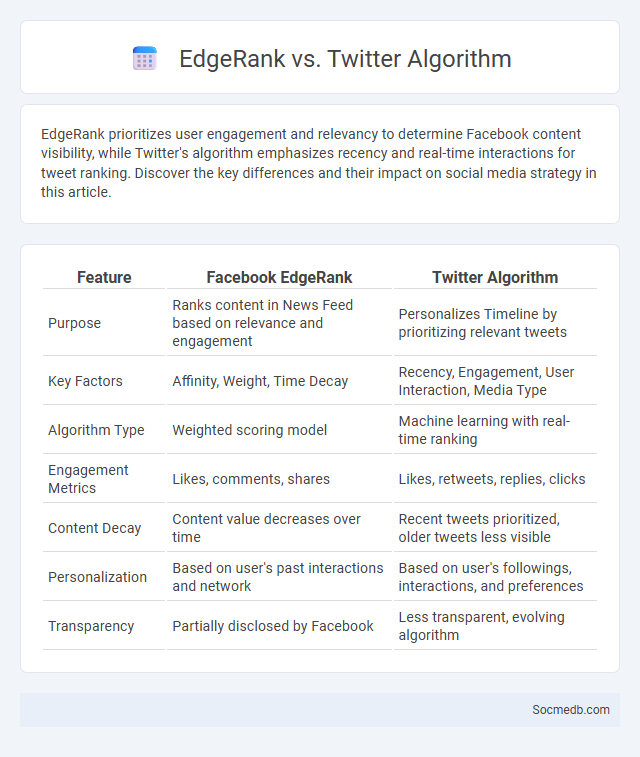
Photo illustration: EdgeRank vs Twitter Algorithm
EdgeRank prioritizes user engagement and relevancy to determine Facebook content visibility, while Twitter's algorithm emphasizes recency and real-time interactions for tweet ranking. Discover the key differences and their impact on social media strategy in this article.
Table of Comparison
| Feature | Facebook EdgeRank | Twitter Algorithm |
|---|---|---|
| Purpose | Ranks content in News Feed based on relevance and engagement | Personalizes Timeline by prioritizing relevant tweets |
| Key Factors | Affinity, Weight, Time Decay | Recency, Engagement, User Interaction, Media Type |
| Algorithm Type | Weighted scoring model | Machine learning with real-time ranking |
| Engagement Metrics | Likes, comments, shares | Likes, retweets, replies, clicks |
| Content Decay | Content value decreases over time | Recent tweets prioritized, older tweets less visible |
| Personalization | Based on user's past interactions and network | Based on user's followings, interactions, and preferences |
| Transparency | Partially disclosed by Facebook | Less transparent, evolving algorithm |
Introduction to Social Media Algorithms
Social media algorithms use complex data analysis and machine learning techniques to personalize content feeds by predicting user preferences based on behavior patterns such as likes, shares, and viewing time. These algorithms prioritize engagement by ranking posts according to relevance, recency, and interaction history, significantly influencing content visibility and user experience. Platforms like Facebook, Instagram, and TikTok continuously update their algorithms to optimize user retention and maximize advertising revenue through targeted content delivery.
What is EdgeRank?
EdgeRank is Facebook's algorithm that determines which posts appear in your News Feed by evaluating the relevance of content based on three key factors: Affinity, Weight, and Time Decay. Affinity measures your relationship with the content creator, Weight assigns value to different types of interactions such as likes, comments, and shares, and Time Decay prioritizes newer content over older posts. Understanding EdgeRank helps you optimize your social media strategy to increase engagement and ensure your posts reach your target audience effectively.
Evolution of EdgeRank: Facebook’s Algorithm Changes
Facebook's EdgeRank algorithm has evolved significantly since its inception, shifting from simple affinity, weight, and time decay factors to a complex machine learning system that prioritizes meaningful interactions and personalized content. This evolution emphasizes user engagement, such as comments and shares, to ensure Your News Feed displays relevant posts tailored to individual preferences. Understanding these changes helps You optimize content visibility and improve social media strategy on the platform.
Understanding the Twitter Algorithm
The Twitter algorithm prioritizes content based on user engagement patterns, relevancy, and timeliness, ensuring that tweets with higher interaction rates such as likes, retweets, and replies gain better visibility on users' feeds. It employs machine learning techniques to analyze behavior signals like tweet impressions and time spent on tweets, enhancing personalized content delivery that aligns with individual interests. Understanding these factors allows users and marketers to optimize tweet timing and content for maximum reach and engagement within the platform's dynamic ecosystem.
Key Differences: EdgeRank vs Twitter Algorithm
The key differences between EdgeRank and the Twitter algorithm lie in their approach to content prioritization; EdgeRank primarily evaluates affinity, weight, and time decay to determine Facebook News Feed visibility, while Twitter uses relevance scores based on recency, user engagement, and content type. Twitter's algorithm emphasizes real-time interactions and trending topics to surface tweets, whereas EdgeRank focuses more on personal connections and interactions over time. Understanding these distinctions helps Your social media strategy tailor content for optimal reach on each platform.
Ranking Signals: Engagement Factors Compared
Engagement factors such as likes, comments, shares, and time spent on posts play a critical role in social media ranking signals, directly influencing your content's visibility and reach. Platforms prioritize content that generates authentic user interaction, indicating relevance and value to the audience. Understanding and optimizing these engagement metrics can significantly improve your social media performance and overall ranking.
Content Prioritization: Facebook vs Twitter
Content prioritization on Facebook uses a sophisticated algorithm that ranks posts based on user engagement, relevance, and timeliness, emphasizing meaningful interactions with friends and family. Twitter prioritizes real-time updates, trending topics, and content from accounts you follow, often highlighting breaking news and popular hashtags. Understanding these differences helps you tailor your posts for maximum visibility and impact on each platform.
Impact on Organic Reach for Brands
Social media algorithms increasingly prioritize paid content, causing a significant decline in organic reach for brands, with studies showing average organic reach dropping below 5% on platforms like Facebook. Brands must optimize content strategy by leveraging engaging visuals, user-generated content, and timely interactions to boost visibility within algorithmic constraints. Effective hashtag usage and active community management also enhance organic reach, making authentic engagement critical for sustained brand growth.
Best Practices for Maximizing Visibility
Consistently posting high-quality, engaging content tailored to your target audience increases social media visibility and fosters organic growth. Utilizing relevant hashtags and optimizing posting times based on audience activity significantly enhances content reach and engagement rates. Engaging actively through comments, shares, and collaborations with influencers further amplifies social media presence and brand awareness.
Future Trends in Social Media Algorithms
Future trends in social media algorithms emphasize enhanced personalization through advanced machine learning techniques, enabling platforms like Facebook and Instagram to deliver highly relevant content tailored to individual user preferences. Increased integration of artificial intelligence enables real-time sentiment analysis and adaptive content curation, optimizing user engagement and retention. Privacy-focused algorithm updates prioritize transparent data usage while balancing targeted advertising and user experience improvements.
 socmedb.com
socmedb.com